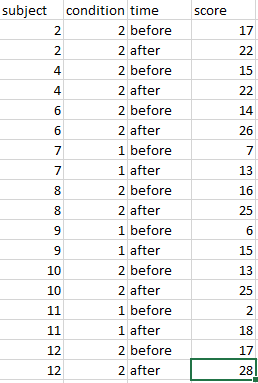I'm trying to get an understanding of how to calculate the sums of squares values in a mixed-model ANOVA (mathematically, not just the syntax for R or SPSS!). I've been trying to figure this out for a long time, but can never seem to find a suitably straightforward explanation of it.
To make things concrete, let's say we have the following (completely fabricated) dataset that I want to run a mixed-model ANOVA on:
before and after are measures of some dependent variable before and after a treatment, and condition is a between-subjects variable specifying the nature of that treatment. How would I go about calculating the sums of squares values for this data? Furthermore, how would I go about calculating F statistics for each factor in the analysis?
Bonus points if you can explain to me how this all relates to linear mixed-effects models or multilevel modelling. I've tried to understand ANOVA in terms of regression, but have become quite lost in doing so.


